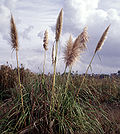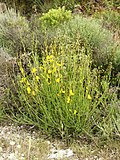Numerous plants have been introduced to Oregon, and many of them have become invasive species. The following are some of these species:
| Picture | Scientific Name | Common Name |
|---|---|---|
 | Ailanthus altissima | tree of heaven |
 | Ammophila arenaria | marram grass |
 | Brachypodium sylvaticum | false-brome |
 | Bromus tectorum | drooping brome |
 | Buddleja davidii | summer lilac |
 | Carduus acanthoides | spiny plumeless thistle |
 | Carduus nutans | musk thistle |
 | Centaurea cyanus | cornflower |
 | Cirsium vulgare | spear thistle |
 | Clematis vitalba | old man's beard |
 | Cortaderia jubata | purple pampas grass |
 | Crataegus monogyna | common hawthorn |
 | Cyperus rotundus | coco-grass |
 | Cytisus scoparius | common broom |
 | Cytisus striatus | hairy-fruited broom |
 | Daphne laureola | spurge-laurel |
 | Egeria densa | large-flowered waterweed |
 | Elaeagnus angustifolia | Russian olive |
 | Euphorbia esula | green spurge |
 | Euphorbia myrsinites | myrtle spurge |
 | Fallopia sachalinensis | giant knotweed |
 | Foeniculum vulgare | Florence fennel |
 | Genista monspessulana | French broom |
 | Geranium lucidum | shining cranesbill |
 | Geranium robertianum | herb-Robert |
 | Hedera helix | common ivy |
 | Hedera hibernica | Atlantic ivy |
 | Ilex aquifolium | common holly |
 | Impatiens glandulifera | impatiens |
 | Iris pseudacorus | yellow flag |
 | Kali tragus | prickly Russian thistle |
 | Koenigia polystachya | Himalayan knotweed |
 | Linaria dalmatica | Balkan toadflax |
 | Linaria vulgaris | common toadflax |
| Logfia gallica | narrowleaf cottonrose | |
 | Lythrum salicaria | purple loosestrife |
 | Phalaris arundinacea | reed canary grass |
 | Pilosella aurantiaca | fox-and-clubs |
 | Reynoutria japonica | Japanese knotweed |
 | Rubus armeniacus | Himalayan blackberry |
 | Rubus laciniatus | cutleaf evergreen blackberry |
 | Salix × fragilis | crack willow |
 | Spartium | Spanish broom |
 | Tamarix ramosissima | saltcedar |
 | Torilis arvensis | spreading hedgeparsley |
 | Ulex | gorse |